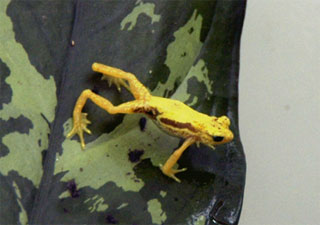Extinctions linked to climate change
Oregon State University release
January 11, 2006
A new report that links global warming to the recent extinction of dozens of amphibian species in tropical America is more evidence of a large phenomena that may affect broad regions, many animal species and ultimately humans, according to researchers at Oregon State University.
A study being published Thursday in the journal Nature finds compelling evidence that global climate change created favorable conditions for a pathogenic fungus in Central and South America. That fungus, in turn, led to widespread extinctions of harlequin frogs at middle elevations of mountainous regions.
In a commentary article in that same publication, an OSU scientist who pioneered the study of global amphibian decline said this is another key example of unanticipated and complex impacts from climate change. The Central and South American crisis is “an amphibian alarm call,” he said, but also is a harbinger of much greater biological disruption. What had been seen as an enigma is now understood as a complex relationship between global warming and major extinction of species.
“This new study is a breakthrough, and the powerful synergy between pathogen transmission and climate change should give us cause for concern about human health in a warmer world,” said Andrew Blaustein, a professor of zoology at OSU, in the Nature article. “As global change is occurring at an unprecedented pace, we should expect many other host taxa, from ants to zebras, to be confronted with similar challenges.”

Related mongabay.com articles Global warming may have triggered worst mass extinction Massive climate change rocked ecosystems, animals 55 million years ago Is Global Warming Killing Polar Bears? — WSJ 794 species on brink of extinction find study |
Very few of the current studies on biodiversity consider how climate affects disease dynamics, said Blaustein. Until the potential impacts of pathogens, parasites and other types of disease transmission are factored in, it will be difficult to accurately gauge the full effects of climate change, and its true impact on biodiversity will often be underestimated, he said.
Five years ago, in a study also published in Nature, OSU scientists documented another of the complex impacts of global warming. In that case, they found that greenhouse warming and other climate changes were increasing the frequency and intensity of El Nino events, which affected precipitation in the Cascade Range of the Pacific Northwest. Ultimately, that resulted in lowered water depths in mountain lakes, higher levels of exposure of amphibian embryos to UV-B radiation in sunlight, and egg mortality in the western toad that approached 100 percent in some years, due to an opportunistic disease.
In the current Nature article, researchers pointed to more examples.
“The climate change in the Arctic and sub-Arctic has modified the life cycle of the nematode parasites of musk oxen,” the researchers said. “These worms can now complete their life cycle in one year, instead of two, and their rising numbers are having a significant impact on musk oxen survival.”
In a similar interaction, Blaustein said, the mountain pine beetle in parts of the western United States is completing its life cycle in one year, instead of two, leading to increasing problems with the fungus they carry. “When pathogens such as this can spread more rapidly, they can do more damage in much less time,” he said.
The problem does not stop with amphibians or other species. Dengue fever, a deadly disease of humans, is increasing its range out of the tropics and is now found in parts of the southern United States. And predicting how climate change will favor a certain pathogen or disease transmission is extremely difficult.
“We should expect the unexpected,” Blaustein and Andy Dobson of Princeton University wrote in their report. “Terms such as ‘enigmatic decline’ and ‘pathogen-climate paradox’ will probably dominate explanations of extinctions until we develop a better understanding of the relationships between global change, pathogens and their hosts.”
For years, zoologists and biologists have been warning that global amphibian declines, which are believed to be caused by climate change, environmental degradation, pollution and invasive species, are just the first examples of a broader biological crisis.
Thousands of amphibian species have declined, and hundreds are on the brink of extinction or have already vanished, a group of 14 researchers said in the new Nature report. They concluded that climate change is promoting infectious disease, eroding biodiversity, and that the urgency of reducing greenhouse gas concentrations is now undeniable.
This article is a modified new release from the Oregon State University.